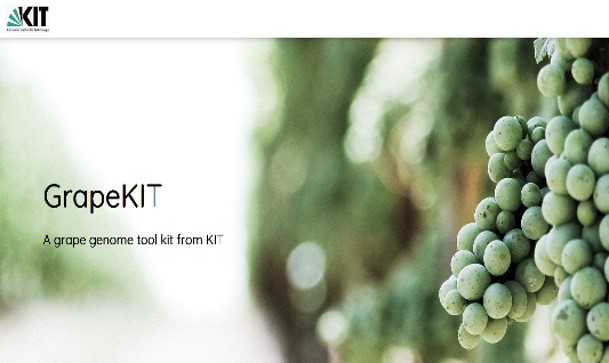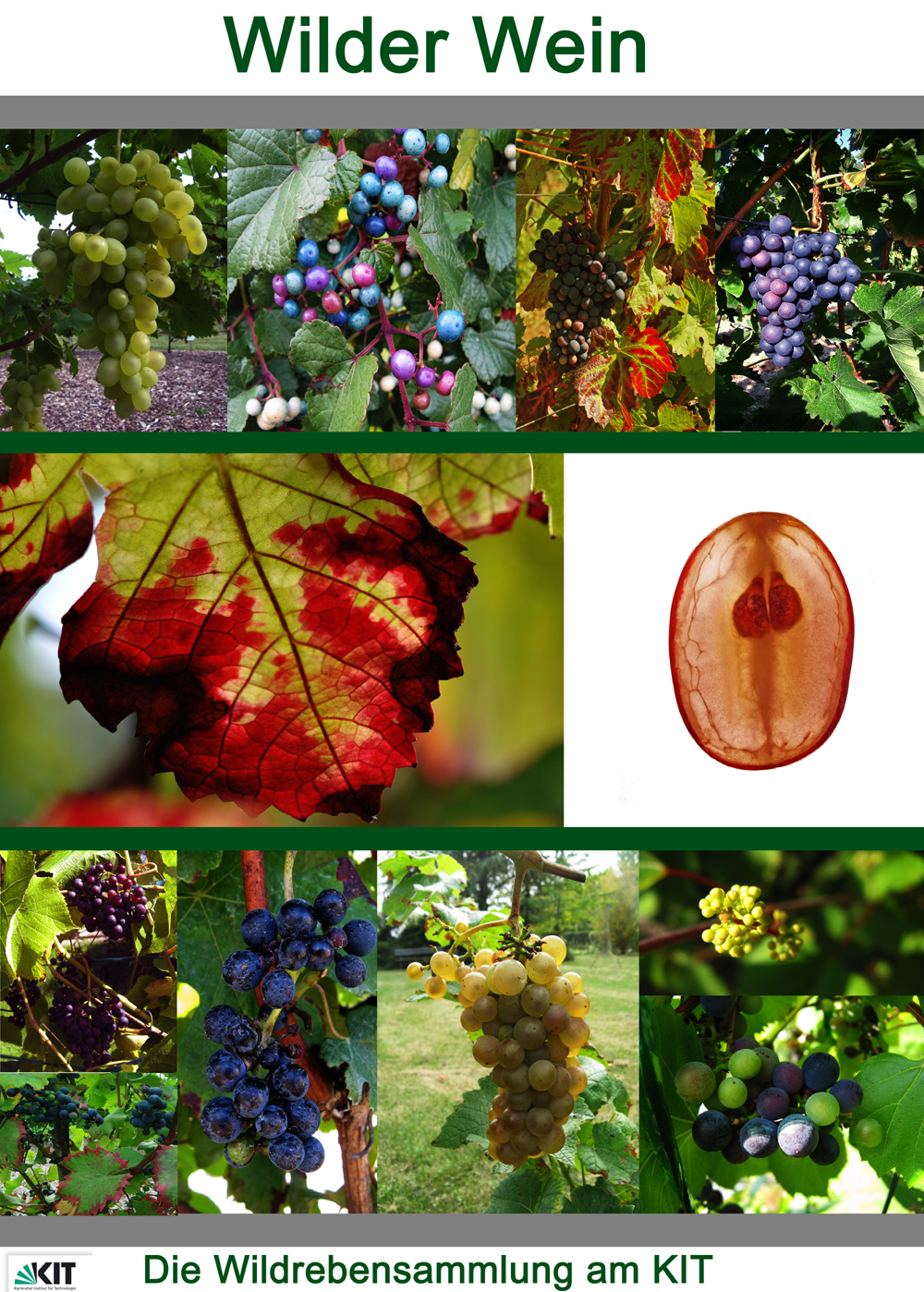Wild Grapes
Our collection of wild grapes is probably the most important genetic resource of the Botanical Garden and integrated into several national and international research projects. It is composed of the following elements:
The Vitis sylvestris collection - The European Wild Grape (Vitis sylvestris) is the ancestor of our domesticated grape, but meanwhile at the verge of extinction. The collection was orignally established in frame of rescue project. On request of the Ministry of Agriculture, we found the last Mohicains of this species, generated vegetative clones, propagated those in the Botanical Garden and brought them back to the wild. In the alluvial jungles of the Rhine peninsula Ketsch we were able to find in 2007-2011 the last remaining 70 individuals along with a few survivors in other sites. Meanwhile, we could rescue additional endangered populations, including an important collection from Armenia (where 9000 years back Grapevine was domesticated). The meanwhile around 100 genotypes represent the entire genetic diversity remaining in Germany for this highly endangered species. Numerous carefuly studies on morphology, cellular structure, genetic diversity and response to different pathogens have rendered this collection into a precious genetic resource, which is not only integrated into the National Plan of Plant Genetic Resources, but also is known internationally. We discovered wild genes that help to improve immunity, such that the collection has also been discovered by grape breeders. We run several national and international projects with the goal of a more sustainable viticulture. In cooperation with the Chinese Academy of Sciences we could decipher almost 200 genomes. These are now integrated into our database GrapeKIT. During our research, we discovered genetic factors that cause a better resilience against numerous diseases, but also the challenges of climate change. This collection is, therefore, interesting also for breeding. Several national and international projects try to render viticulture more sustainable. Since we were able to identify some of the important genes, we can search our database for variants of these genes, pick the corresponding plant from our collection and continue working with them. Our newest project: In frame of a new Interreg Upper Rhine network coordinated by us, we want to use factors from wild grapes to breed new varieties with a better resilience against climate-born stress. These KliWi grapes (from Klimawiderstandsfähig, German for climate resistant) may help viticulture in the region to cope better with the consequences of climate change.
Genus Vitis - This collection was established in 2005-2010 and contains from almost all wild species at least one accession. Using this collection, we were able to develop, for the first time, a molecular phylogeny of the genus Vitis (Tröndle et al. 2010). This collection was also used to investigate the behaviour of Plasmopara viticola, the pathogen causing Downy Mildew. We discovered that wild grapes from China secrete a scent that is able to mess up the orientation of the flagellate spores of this pathogen, such that it fails to target the stomata (Jürges et al. 2009). The collection also comprises representatives from related genera, such as the jungle vine Leea guinense or several accessions of the succulent South African Cyphostemma. This collection is often requested for evolutionary studies on grapevine and its diseases.
The Vitis sylvestris collection - The European Wild Grape (Vitis sylvestris) is the ancestor of our domesticated grape, but meanwhile at the verge of extinction. In frame of a project funded by the Ministry of Agriculture, we found the last Mohicains of this species, generated vegetative clones, propagated those in the Botanical Garden and brought them back to the wild. In the alluvial jungles of the Rhine peninsula Ketsch we were able to find in 2007-2011 the last remaining 70 individuals along with a few survivors in other sites. The meanwhile around 100 genotypes represent the entire genetic diversity remaining in Germany for this highly endangered species. Numerous carefuly studies on morphology, cellular structure, genetic diversity and response to different pathogens have rendered this collection into a precious genetic resource, which is not only integrated into the National Plan of Plant Genetic Resources, but also is known internationally. We discovered wild genes that help to improve immunity, such that the collection has also been discovered by grape breeders. We run several national and international projects with the goal of a more sustainable viticulture.
Collection of domesticated varieties – since the diversity of domesticated grapes is well represented in several sites in Germany, such as the Julius-Kühn-Institute Geilweilerhof, we focus on old landraces that are absent from other collections, for instance the more than 30 medieval varieties, thought to be extinct that had been rediscovered by Dr. Andreas Jung in abandoned vineyards in East Germany and identified by old illustrations and molecular genetic methods. A second focus is on so called Teinturier grapes traditionally used to dye red wines. These grapes produce the pigment anthocyanin in an unregulated manner, such that also the pulp or even the leaves are coloured deep red. We have assembled a collection of Teinturier grapes from all over the world and currently investigate, how this curious trait evolved several times independently during domesticaiton. In addition to interesting landraces from Tunisia and the Canary Islands, we also grow economically relevant varieties for research that is relevant for wine industry.
Characterisation – Our collection, which meanwhile comprises several hundreds of genotypes, is carefully characterised and investigated to make sure that the extracted data can be linked to a comprehensive understanding of grape biology. To safeguard the link between the numerous projects, each grape accession is registered under a ID that never changes, no matter, whether this grape changes sometimes name or nomenclature (which is not uncommon, since traditional names are often ambiguous). The collection is also mapped genetically using highly resolving microsatellite markers (as they are used for paternity assays), and we also conduct detailled studies on leaf and wood structure. How dense are the stomata, are there wax structures on the surface, how are leaves shaped? This is all measured, counted, and documented. Moreover, resistance factors against grape diseases such as Downy or Powdery Mildew, Black Rot, but also the newly emerging Esca Syndrome, are mapped and analysed as well as the ability for the formation of defence compounds (so called stilbenes). When we find interesting traits, we dig deeper and by this have already discovered novel exciting genes, such as a highly active version of the gene switch MYB14 that can boost stilbene formation. In cooperation with the Julius-Kühn-Institute Geilweilerhof we even have already crossed such wild grape „champions“ with domesticated grapes to introduce such resistance factors into economically relevant varieties. Since we could already decipher numerous genomes and integrate them into the GrapeKIT database, the search for new resilience factors will become far easier


